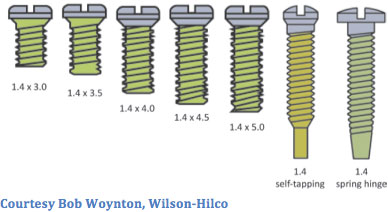Newcomers to Opticianry will discover a very heated and passionate debate over the efficiency, durability, and desirability of hinge type. Each has its own advantages and disadvantages, and various opticians will have different viewpoints, affected by factors from how long they have been opticians to personal experience with different hinge types.
Generally speaking, the optician community seems to favor standard hinges. They are more often than not the first type of hinge that most opticians have had experience with, and are also the most easily to repair. In the event of damage or breakage, one must simply insert a new screw to make the glasses functional once more. Additionally, since screws are a readily available commodity, one rarely runs the risk of not having the supplies on hand to make repairs. This is also the design preferred by many high-end frame manufacturers, not only for its’ time-proven efficiency, but also because a multiple barrel standard hinge design lends itself to high durability, therefore giving the product a better reputation as a solid piece of manufacturing. As such, there is a close association in optics between standard hinges and high-quality frames. However, frames with standard hinges come with what some might view as drawbacks: They require more and specific adjustment in order to not only comfortably conform to the wearer’s head, but also to ensure that they do not slip off when the wearer is looking down or engaged in a physical activity.
Standard hinge frames must also be of a relatively close size to the wearer’s head to fit properly: Too large, and they will not be able to be adjusted to stay in place. Too small, and the temples will squeeze the wearer’s head, potentially causing pain and discomfort. Often, frame measurements will also include the distance between barrel screws. This is an indication of frame width and can be correlated directly with face width though not commonly used.
Spring hinges, conversely, are more often preferred by patients, and will often be requested by name. Because they require few adjustments, spring hinge frames tend to fit most patients “out of the box;” similarly, many patients enjoy the subtle tension created against their heads by the resistance of the spring, which gives a sense of extra security. Because of the flex of the spring, patients for whom the frame would normally be too small, without it gouging into his or her temples and causing pain, can wear spring hinge frames. Also, just as opticians link high-quality frames with multi-barrel standard hinges, many consumers link low-quality frames with low-barrel standard hinges.
However, spring hinges also have several down sides: Though they can stand up well to wear-and-tear, they are significantly more difficult to repair than standard hinges, and require the use of special supplies. Even if an optician has the necessary tools and supplies on hand, this can still prove to be a difficult and time consuming process, and depending on the extent of damage to the hinge, repairs may not be possible at all. Additionally, while the design for spring hinges is relatively standard across the industry, some manufacturers have their own variations, which may make them more difficult to repair or even require custom parts from the manufacturer, a rare instance when dealing with standard hinges.
As you continue your career in Opticianry, you will encounter multiple viewpoints from patients as well as fellow opticians as to which hinge type is superior, my survey of opticians suggests that they generally prefer standard hinges while patients generally prefer spring hinges. Although you may ultimately develop a preference for one over the other based upon your own experience, it is ultimately most important to consider the patient’s needs and desires. Explaining the various advantages and disadvantages to the patient will allow him or her to come to his or her own informed decision regarding which type of hinge is best.
NOT SCREWING UP
In making frame repairs, you will nominally encounter two types of screws: Standard screws, and Snap-Its. Of course, there are differences between eyewire, temple and nosepad screws.
Standard Screws:
Standard screws are of the exact variety you’ve probably used in various hardware projects, except much, much tinier. They come in a variety of shapes and sizes, measured in millimeters. They are measured according to thread size, shaft diameter, and length; with the thread size listed first, then the shaft diameter and finally the length. For example, a screw with a thread size of 2.5 mm, a shaft diameter of 1.3 mm, and a length of 9.6 mm would be listed as such: 2.5 x 1.3 x 9.6

As with screws applied in any other area, eyeglass hinge screws come in both Phillips and flathead varieties; there is no real standardization according to manufacturer or frame type. The majority of frames require screws that are 1.4 mm in diameter, with some thinner wire frames using 1.2mm screws. As we will discuss in a moment, thread size and shaft diameter are more important than shaft length in replacing screws.
Snap-Its:
Snap-Its are unique screws that have a long, thin, easily broken sliver of metal attached to the base of the screw which can be used as a guide to lead the screw through the barrels. Although useful for individuals who have a difficult time aligning a screw, their best application is in the repair of spring hinges.













